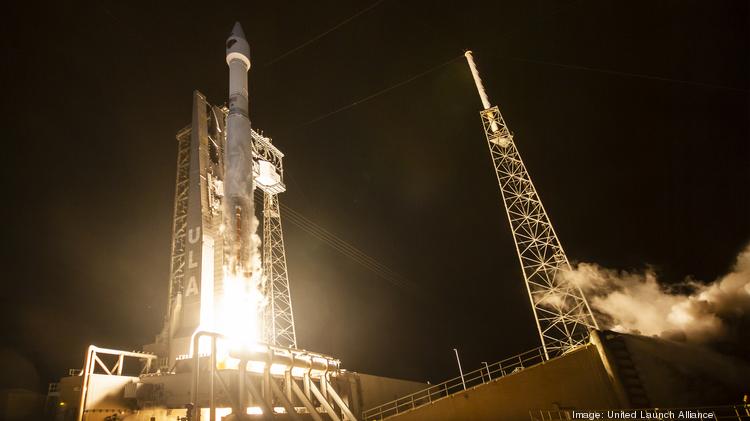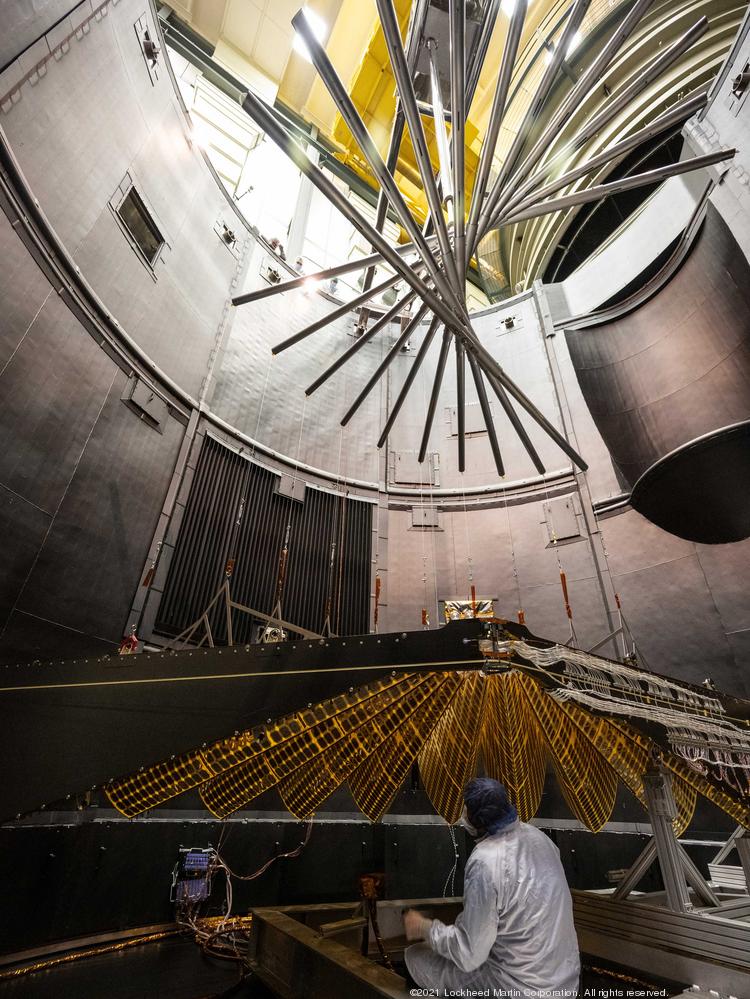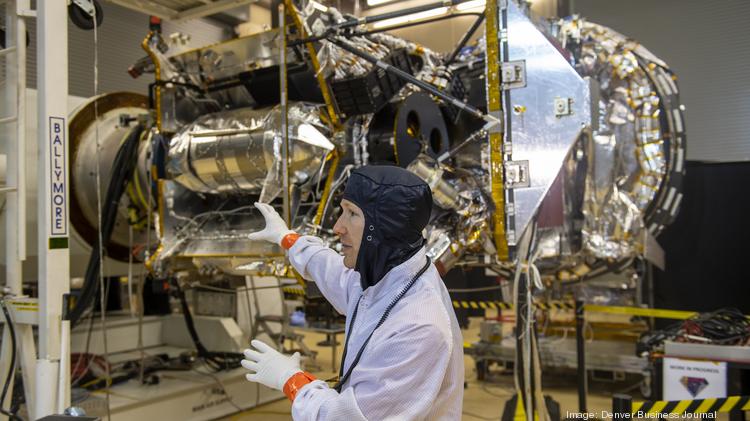Enlarge
A Lockheed Martin Space worker tests the deployment of one of the 24-foot- diameter solar arrays that power NASA's Lucy space probe. The spacecraft was built and tested at the company's headquarters in Jefferson County.
PATRICK H. CORKERY
By Greg Avery – Senior Reporter,
A Lockheed Martin Space worker tests the deployment of one of the 24-foot- diameter solar arrays that power NASA's Lucy space probe. The spacecraft was built and tested at the company's headquarters in Jefferson County.
PATRICK H. CORKERY
By Greg Avery – Senior Reporter,
Denver Business Journal
13 hours ago
NASA’s Lucy space probe, built in Jefferson County by Lockheed Martin Space, started its 4-billion-mile journey to study rare asteroids near Jupiter on Saturday, but the company and space agency are sorting out an apparent glitch in deploying the spacecraft’s solar arrays.
One of two 24-foot in diameter, circular solar arrays may not have “latched” into place after unfurling, and, while the $450 million space probe otherwise is functioning as planned, officials are trying to latch the array and understand if it might affect the planned 12-year research flight.
“Lockheed Martin and its Lucy mission operations flight team are working closely with NASA to address the situation with the spacecraft’s solar array,” Lockheed Martin Space said in an email statement issued by spokeswoman Lauren Duda. “We’re fully dedicated to the health, safety and success of the Lucy mission and team.”
The 3,300-pound Lucy launched successfully from Cape Canaveral Space Force Station in Florida before dawn Saturday on an Atlas V rocket made by Centennial-based United Launch Alliance.

13 hours ago
NASA’s Lucy space probe, built in Jefferson County by Lockheed Martin Space, started its 4-billion-mile journey to study rare asteroids near Jupiter on Saturday, but the company and space agency are sorting out an apparent glitch in deploying the spacecraft’s solar arrays.
One of two 24-foot in diameter, circular solar arrays may not have “latched” into place after unfurling, and, while the $450 million space probe otherwise is functioning as planned, officials are trying to latch the array and understand if it might affect the planned 12-year research flight.
“Lockheed Martin and its Lucy mission operations flight team are working closely with NASA to address the situation with the spacecraft’s solar array,” Lockheed Martin Space said in an email statement issued by spokeswoman Lauren Duda. “We’re fully dedicated to the health, safety and success of the Lucy mission and team.”
The 3,300-pound Lucy launched successfully from Cape Canaveral Space Force Station in Florida before dawn Saturday on an Atlas V rocket made by Centennial-based United Launch Alliance.

Enlarge
A United Launch Alliance rocket lifts off from the launch pad at Cap Canaveral Space Force base, Florida, before dawn Oct. 16, 2021. It was the Centennial-based company's fourth launch of the year and its 146 consecutive successful mission.
UNITED LAUNCH ALLIANCE
Lucy was released from the rocket’s upper stage 58 minutes after launch, starting a complicated flight path to reach eight, rare Trojan-class asteroids orbiting the sun in two clusters, held in place by Jupiter’s gravity and traveling in the same orbital plane as the giant planet.
Lucy is designed to travel farther than any solar-powered spacecraft ever launched. The solar arrays, built by Northrop Grumman, are meant to generate 504 watts of electricity at the furthest Lucy will be from the sun, a distance at which the sun’s light is several times weaker than near earth.
The spacecraft unfurled its two solar arrays after launch to charge its batteries, each one unfolding like a Chinese hand fan.

A United Launch Alliance rocket lifts off from the launch pad at Cap Canaveral Space Force base, Florida, before dawn Oct. 16, 2021. It was the Centennial-based company's fourth launch of the year and its 146 consecutive successful mission.
UNITED LAUNCH ALLIANCE
Lucy was released from the rocket’s upper stage 58 minutes after launch, starting a complicated flight path to reach eight, rare Trojan-class asteroids orbiting the sun in two clusters, held in place by Jupiter’s gravity and traveling in the same orbital plane as the giant planet.
Lucy is designed to travel farther than any solar-powered spacecraft ever launched. The solar arrays, built by Northrop Grumman, are meant to generate 504 watts of electricity at the furthest Lucy will be from the sun, a distance at which the sun’s light is several times weaker than near earth.
The spacecraft unfurled its two solar arrays after launch to charge its batteries, each one unfolding like a Chinese hand fan.

Enlarge
Testing deployment of the solar arrays for NASA's Lucy space probe in early 2021 at Lockheed Martin Space's headquarters campus.
PATRICK H. CORKERY
There were indications that one of the two arrays didn’t latch into place as planned after it unfurled, NASA said Sunday. Both arrays were collecting power, Lucy’s batteries started charging, and all other systems were operating normally, NASA said.
“In the current spacecraft attitude, Lucy can continue to operate with no threat to its health and safety. The team is analyzing spacecraft data to understand the situation and determine next steps to achieve full deployment of the solar array,” NASA said in a Sunday blog post.
Lucy is scheduled to fly by four Trojan asteroids over 12 months starting in 2027. Then, after looping across the solar system assisted by earth and Jupiter’s gravity, it’s slated to reach the second swarm of Trojan asteroids in 2033.
Harold “Hal” Levison, chief scientist at the Southwest Research Institute office in Boulder, conceived of Lucy and is principal investigator leading its research mission.
The Trojan asteroids, unlike the ones orbiting in the asteroid belt just past Mars, are believed to be remnants of the material that pre-dates the solar system and came together billions of years ago to make planets.
Studying the asteroids is hoped to reveal insights about the processes that made planets and formed the solar system that exists today.

Testing deployment of the solar arrays for NASA's Lucy space probe in early 2021 at Lockheed Martin Space's headquarters campus.
PATRICK H. CORKERY
There were indications that one of the two arrays didn’t latch into place as planned after it unfurled, NASA said Sunday. Both arrays were collecting power, Lucy’s batteries started charging, and all other systems were operating normally, NASA said.
“In the current spacecraft attitude, Lucy can continue to operate with no threat to its health and safety. The team is analyzing spacecraft data to understand the situation and determine next steps to achieve full deployment of the solar array,” NASA said in a Sunday blog post.
Lucy is scheduled to fly by four Trojan asteroids over 12 months starting in 2027. Then, after looping across the solar system assisted by earth and Jupiter’s gravity, it’s slated to reach the second swarm of Trojan asteroids in 2033.
Harold “Hal” Levison, chief scientist at the Southwest Research Institute office in Boulder, conceived of Lucy and is principal investigator leading its research mission.
The Trojan asteroids, unlike the ones orbiting in the asteroid belt just past Mars, are believed to be remnants of the material that pre-dates the solar system and came together billions of years ago to make planets.
Studying the asteroids is hoped to reveal insights about the processes that made planets and formed the solar system that exists today.


No comments:
Post a Comment